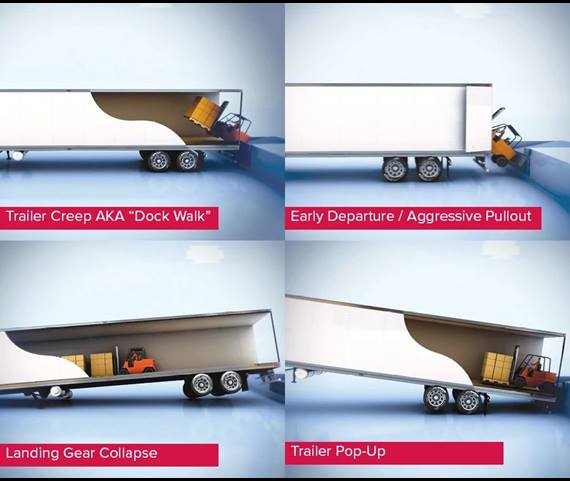Shadow Hook
View
Someone from our team will be in touch with you shortly.
Rite-Hite's approach to reducing loading dock accidents combines loading dock products with an integrated digital software platform, effectively mitigating risks such as trailer creep, early departure, and landing gear collapse. This comprehensive strategy addresses specific challenges to enhance safety and prevent accidents in critical loading dock operations.
Every loading dock is at risk for trailer separation accidents, which primarily involve a forklift, material handler and truck. With almost 900,000 forklifts in operation in the United States, those numbers amount to a 1 in 10 chance that each forklift working in a facility will be involved in an accident this year. While forklifts are a heavy-duty piece of industrial equipment made for wear and tear, 80% of those reported accidents involve a pedestrian - with 1 out of every 6 workplace deaths in the U.S. being forklift related. So regardless of how durable the equipment is, facility's need to put measures in place to safeguard their most valuable assets - their employees.
When focusing on the loading dock, it’s reported that 7% of forklift accidents occur when material handling equipment is driven or falls off the edge of a dock. OSHA took measures to address trailer separation accidents in 1978 when they mandated the use of wheel chocks to restrain trailers to the loading dock. Standard (29 CFR 1910.178(k)(1) and (m)(7)) was amended in 1981, one year after the introduction of the original Dok-Lok®, to include “mechanical means” as a preferred alternative to wheel chocks.
Even with OSHA mandates in place, it’s important for facility safety managers to understand that workplace safety is a dynamic field, and regulations and practices continue to change over time. For a loading dock to be safe, it’s imperative facilities stay updated with the latest information and prioritize safety measures to help prevent these traditional trailer separation accidents at the dock:
1. Trailer Creep, also known as dock walk, is the repeated impact from lift trucks going in and out, that causes the trailer to edge (“creep”) away from the dock. Simple wheel chocks fail to properly address this concern as they can slip, get misplaced, be pushed or pulled out of the way, and most importantly – require boots on the ground.

2. Early Departure, also known as aggressive pullout, occurs when a truck driver mistakenly drives away while a lift truck is entering, leaving or still inside the trailer. This trailer separation accident is caused by improper trailer restraints as well as lack of full-time loading dock communication.
3. Landing Gear Collapse, also known as trailer tip-over, occurs when the leg of the landing gear of a spotted (dropped) trailer collapses. If the leg rolls inward or outward, it causes the trailer to tip sideways which could be catastrophic to material handling equipment, products, and personnel if inside the trailer when it happens.
4. Trailer Pop-Up or Up-Ending, occurs when the weight of the product being loaded/unloaded paired with forklift’s weight causes the trailer to shift to the nose or rear. This accident type most commonly occurs when loading a dropped trailer since the cab is no longer present to help counterbalance the trailer’s weight.
Each distinct type of trailer separation accident that can occur during loading and unloading are attributed to specific factors such as repeated lift truck impacts, aggressive pullouts, landing gear collapse, and weight distribution issues, emphasizing the need for improved safety measures beyond traditional simple wheel chocks.
Choosing the Rite Loading Dock Equipment.
It’s important to understand application needs in order to select the proper loading dock equipment configuration, which is essential to address trailer separation accidents. For example, understanding your facility's current load styles - either dropped, live or both - can greatly impact your vehicle restraint selection and ultimately the amount of accident protection equipment provides. In a dropped loading scenario for example, it’s imperative that facilities understand the need to provide counterbalancing measures as the cab is no longer present to do so. Trailer type plays an identically important role to load style as all trailers are not created equal, some have liftgates, various tire diameters, obstructed RIGs, etc.
The Rite Solution.
Once facilities understand their application needs, they can then choose the right combination of loading dock solutions to address trailer separation accidents. The critical pieces of equipment that are part of the greater solution, include:
Rite Here for You.
Regardless of equipment selection and application needs, a crucial step is partnering with someone who understand the challenges of today and tomorrow’s loading docks. Rite-Hite provides years of dedicated experience in equipment design and application, backed by industry-leading warranties, and is prepared to help reduce trailer separation accidents at any dock. Partner with a loading dock expert to learn more!

Fill out the form below and one of our reps will reach out to you.
Someone from our team will be in touch with you shortly.